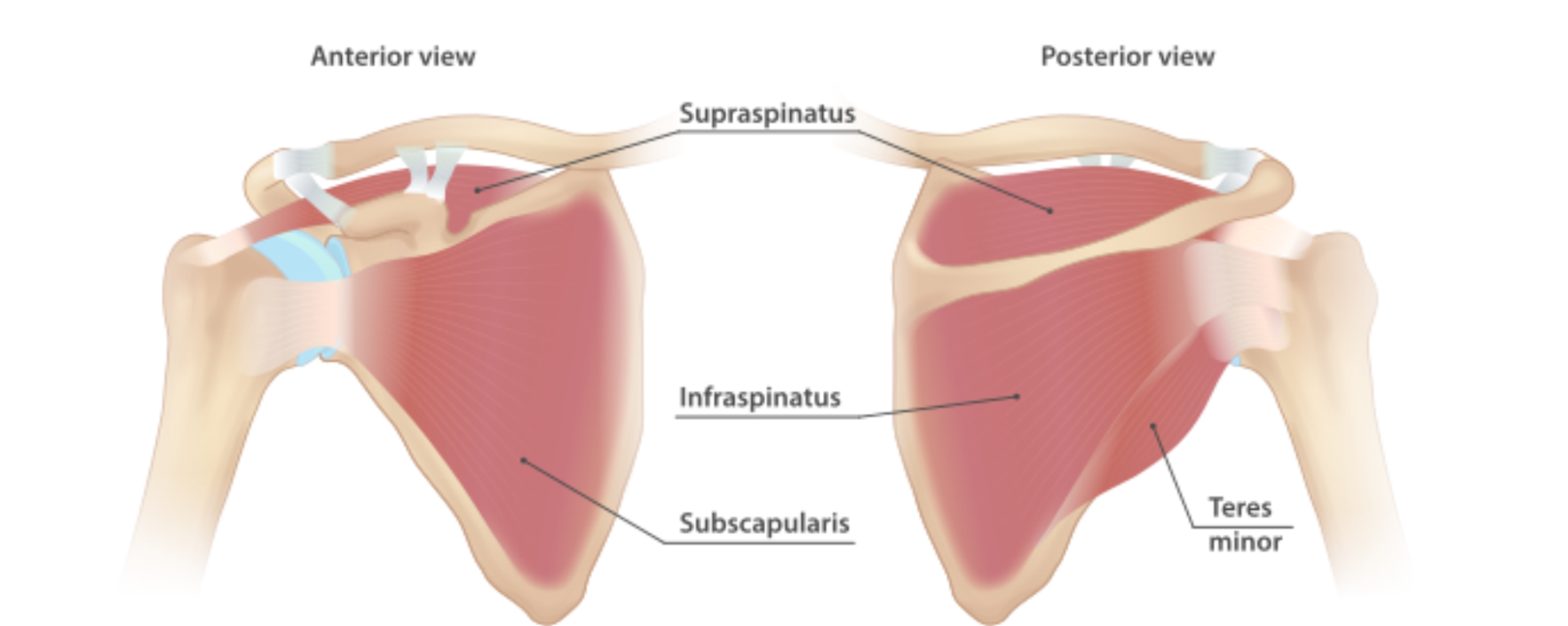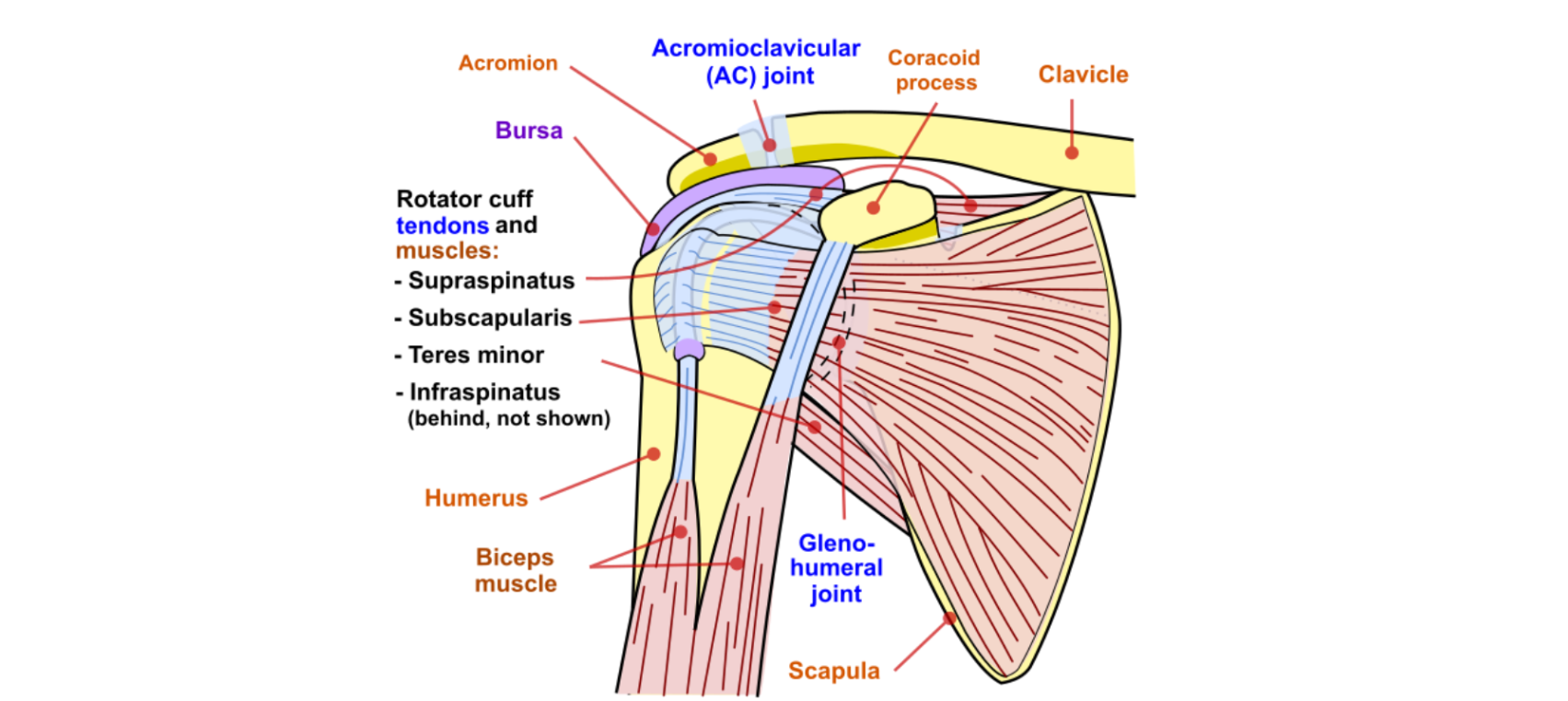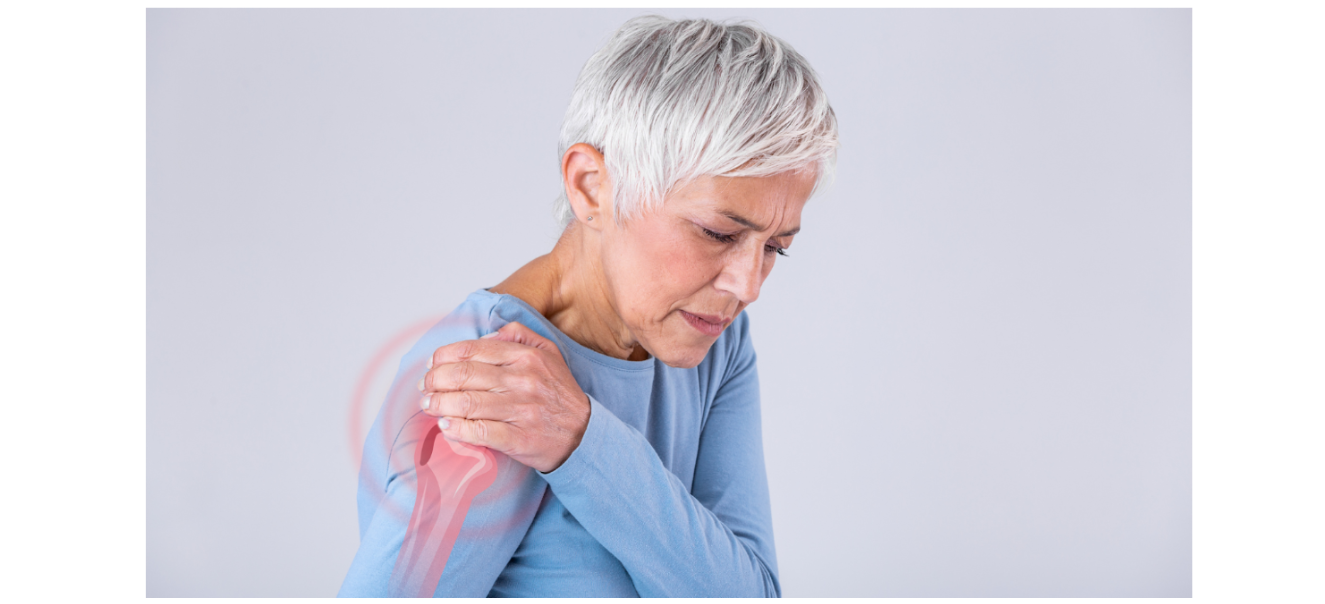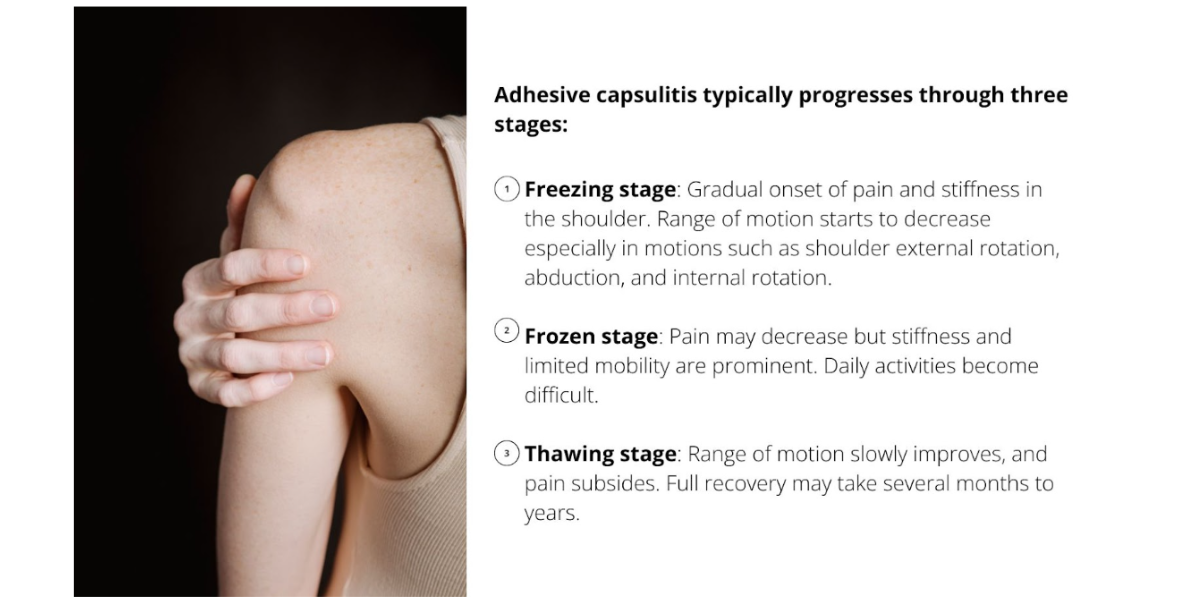
|
Dr.Kimberly Huynh |
|
|
June 27, 2024 · 10 min |
The shoulder, also known as the glenohumeral joint, is the most mobile joint in the body. It has a tremendous range of motion, including flexion, extension, internal rotation, external rotation, adduction, abduction, and 360° circumduction in the sagittal plane. This extensive mobility makes it highly susceptible to injuries and various problems.
The glenohumeral joint is a ball-and-socket joint consisting of the humerus (upper arm bone), the clavicle (collarbone), and the scapula (shoulder blade). The shoulder complex is stabilized by the rotator cuff muscles, their tendons, and ligaments.
Shoulder pain, whether a dull ache or sharp pain, can interfere with your daily quality of life. Shoulder problems can arise from misuse, overuse, or injuries to the shoulder complex. Shoulder pain is common in people of all ages, but fortunately, most conditions can be treated conservatively.

Chiropractic care can help relieve shoulder pain, restore motion, and improve other symptoms of shoulder conditions through adjustments, soft tissue therapy, rehab exercises, and injury prevention care.
Chiropractors may help with shoulder conditions such as:
• Rotator Cuff Injuries
• Arthritis
• Repetitive Motion Injuries (Cumulative Trauma Disorder)
• Shoulder Impingement
• Frozen Shoulder
• Tendinitis
• Bursitis
• Shoulder Instability
Read on for more information about common shoulder conditions, their causes, signs and symptoms, and how chiropractic care can help.

The rotator cuff is made up of four SITS muscles: the supraspinatus, infraspinatus, teres minor, and subscapularis. These muscles and their tendons stabilize the shoulder and allow for its extensive range of motion. Causes Rotator cuff injuries can occur due to: • Acute injuries, such as trauma from a single violent force to the shoulder, falling, lifting, or sudden jerking motions • Chronic overuse from repetitive overhead activities, such as throwing, swimming, or painting • Age-related degeneration, commonly seen in individuals aged 45 to 65 Sign and Symptoms • Recurrent pain • Muscle weakness • Popping, grating, or grinding sounds • Limited range of motion such as difficulty with overhead motion • Difficulty sleeping on the affected side • Tenderness around the affected area • Inflammation

Treatment Conservative care can generally help with rotator cuff injuries. Chiropractic care can help with gentle joint adjustments, soft tissue therapy, corrective exercises, as well as lifestyle advice such as ergonomics, sleeping positions, and proper technique when necessary. If a tear is suspected, additional imaging may be required. If these treatments fail to bring relief, cortisone injections and/or surgical options (e.g., arthroscopic repair for tears) may be discussed with the doctor. Rotator cuff injuries can significantly impact daily activities and quality of life. Early diagnosis and appropriate treatment are crucial for recovery. Conservative treatments are often effective, but surgical options are available for more severe cases. Preventative measures, including regular exercise and proper technique, can help reduce the risk of rotator cuff injuries.

Shoulder arthritis is a condition characterized by inflammation and degeneration of the shoulder joint where the cartilage deteriorates. It typically affects the glenohumeral joint or the acromioclavicular (AC) joint.
Causes
• Wear and tear of the shoulder may lead to a degenerative condition called osteoarthritis
• Family history of arthritis may increase the likelihood of arthritis
• Previous injuries can increase degeneration of the shoulder joint
• Autoimmune disorders such as rheumatoid arthritis
• Muscle imbalances
Signs and Symptoms
• Stiffness especially in the morning
• Limited range of motion
• Pain
• Weakness
• Crepitus (i.e. grinding, cracking, or clicking when moving the shoulder)
Treatment
Chiropractic care focuses on gentle joint mobilization and physical therapy. Regular exercise, proper technique, and a healthy lifestyle can help prevent the onset or progression of shoulder arthritis. Application of ice or heat may help with pain relief. NSAIDs and injections may be another option.
Using the same arm repeatedly can stress the joint and exacerbate the involved soft tissue, potentially leading to a repetitive motion injury known as cumulative trauma disorder (CTD). CTD affects the musculoskeletal system, including joints, muscles, tendons, ligaments, nerves, and blood vessels. Occupations such as office workers, assemblers, meat packers, sewing machine operators, buffers/grinders, bricklayers, and housekeepers are particularly prone to developing CTD.
Causes
• Repetitive movements (e.g., overuse)
• Forceful exertions (e.g., pulling, pushing, lifting, gripping)
• Work-related factors (e.g., vibrational forces from using a jackhammer)
• Awkward posture over extended periods
• Insufficient recovery time
Signs and Symptoms
• Tight and tender shoulder muscles
• Pain
• Swelling
Treatment
Steps can be taken to make “high risk” jobs safe, including ergonomic changes such as adjusting work stations, using proper technique and equipment, and taking regular breaks. Chiropractic care aside from adjustments and soft tissue therapy may include therapeutic stretches and strengthening exercises.
Shoulder impingement occurs when tendons, such as the supraspinatus or biceps, get pinched or irritated from the lack of joint space between the acromion and humerus. It is a common chronic condition in people who are extremely hypermobile. The extra flexibility leads to repetitive stress and inflammation. Causes • Sports that include repetitive overhead movements • Work with excessive overhead arm motions • Sleeping on the same side of the arm overtime • Trauma to the affected shoulder

Signs and Symptoms • Poor posture including rounded shoulders and forward head posture due to muscle imbalances, which can contribute to impingement • Dull achy pain at rest • A ‘pinching’ sensation when raising arm • Pain when sleeping on the affected side • Accompanying pain with certain arm movements Treatment Treatment includes a variety of options ranging from rest, chiropractic adjustments, soft tissue therapy, biomechanical training, physical therapy modalities, to lifestyle advice such as avoiding side-sleeping on a firm mattress. Corrective posture training may decrease pain and discomfort with shoulder impingement including shoulder-opener and upper back exercises.
Frozen shoulder or known as ‘adhesive capsulitis,’ is an inflammatory condition characterized by stiffness, pain, and significant decrease in passive range of motion. Adhesive capsulitis affects approximately 2 to 5 percent of the general population, with a slightly higher predominance in females (1.4:1) [3]. The exact pathophysiology is unknown, but the leading hypothesis shows that inflammation initiates within the shoulder capsule, causing reactive fibrosis and adhesions causing pain and reduced range of motion.

Causes • The exact cause is unknown but risk factors for frozen shoulder includes: • Idiopathic (no clear cause) • Immobilization, most commonly when an individual is overly protective of their injured shoulder by immobilizing it • Medical conditions such as diabetes, thyroid disorders, and cardiovascular disease • Age and gender (more common in individuals aged 40-60 years and more frequently in females) Signs and Symptoms • Often affecting the non-dominant arm • Stiffness • Pain • Restricted motion • Inflammation Treatment Chiropractic care aims to enhance shoulder joint mobility and alleviate pain. Treatment often includes gentle mobilization and manipulations of the shoulder, neck, and upper back (thoracic spine), combined with stretching and soft tissue therapy. Moist heat or ice packs may also be recommended. Physical rehabilitation may involve specific shoulder stretches and gentle exercises like broomstick exercises demonstrated by the chiropractor. If conservative methods are ineffective, cortisone injections or surgical interventions may be considered.
Tendinitis refers to inflammation of a tendon, commonly affecting the rotator cuff and/or biceps tendon in the shoulder due to irritation from nearby structures. The severity can range from mild inflammation to extensive involvement of the rotator cuff. In cases where the rotator cuff tendon becomes inflamed and thickened, it may become trapped beneath the acromion. Causes • Overuse / repetitive activities • Injury • Sports requiring throwing or overhead arm movements (i.e. swimming) • Aging causing wear-and-tear of the tendon Signs and symptoms • Inflammed and thickened tendon • Redness, soreness, and swelling of a tendon • Discomfort and pain of the upper shoulder • Difficulty sleeping on the affected shoulder • Pain at night • Pain with overhead activities and/or rotational movements Treatment Most cases of tendonitis can be successfully treated by reducing inflammation through rest, ice, and anti-inflammatory medications as needed. Chiropractic manipulations, stretching, and soft tissue massage are often employed to alleviate symptoms. Additionally, instrument-assisted massage therapy can help break down soft tissue adhesions and promote blood flow. Cupping therapy may also aid in decompressing surrounding structures of the tendon.
Between the shoulder joints are fluid-filled sacs called bursae, which reduce friction between bones. Bursitis, the inflammation of these bursae, can cause significant pain upon touch, resulting from irritation to the bursa. Causes • Repetitive irritation to the bursa • Infections (bacterial) • Inflammatory conditions such as rheumatoid arthritis, gout, and diabetes can cause secondary inflammation to the bursa Sign and symptoms • Inflammation (i.e.warmth, redness, swelling) • Pain • Tenderness • Fever if infection present Treatment Gentle chiropractic manipulations, stretching, and surrounding soft tissue therapy are often part of the treatment approach. Similar to tendinitis, the focus is on reducing inflammation with rest and ice. The chiropractor may also suggest activity modification or brief immobilization. Additionally, anti-inflammatories, injections, aspiration, or antibiotics (in cases of infection) may be considered as alternative treatment options.
Shoulder instability refers to the inability of the shoulder joint, consisting of the ball (humeral head) and socket (glenoid fossa), to maintain its normal alignment. It usually occurs when the lining of the shoulder joint (the capsule(, ligaments, or labrum become stretched, torn, or detached, allowing the ball of the shoulder joint (humeral head) to move out of the socket either partially or completely. Causes • Risk factors include previous shoulder dislocations, generalized joint hypermobility, conditions like Ehlers-Danlos syndrome • Engagement in high-risk activities such as overhead activities, throwing, overuse/repetitive motions • Congenital anomalies (e.g., glenoid dysplasia) • Direct traumas from falling, running into something or someone, lifting incorrectly, or reaching beyond the anatomical safety zone Signs and symptoms • Sulcus sign • Redness • Tenderness to the touch • Repeatable clunk or apprehension with shoulder abduction and external rotation • Altered scapulohumeral rhythm • Pain worse with certain arm positions • History of catching or locking with motion

Treatment If the shoulder is dislocated, immediate medical attention is crucial for reduction. General pain and inflammation management measures such as rest and heat can be recommended. Chiropractic manipulations may be contraindicated directly to the joint but can offer benefits to surrounding joints in the affected area. Massage therapy focused on the shoulders, neck, and upper back regions can also provide pain relief. A rehabilitation program is strongly advised to enhance shoulder stability. In cases where conservative care proves ineffective, open or arthroscopic surgery may be considered as an option.
Paradise Chiropractic can help with an array of shoulder problems. Chiropractic care begins with a thorough history and physical examination to help determine the exact location and extent of the injury. Treatment options include chiropractic manipulations, soft tissue therapy, rehab, and lifestyle recommendations to aid in recovery. The health benefits of chiropractic care include: • Reducing pain and discomfort • Decreasing inflammation • Improving range of motion and flexibility • Increased muscle strength and tone Our goal is to promote a wide pain-free range of motion and promote strong shoulders. Let your chiropractor help you with the nagging shoulder pain so you can continue doing the things you love. Give us a call at (604) 496-0626, email at info@paradisechiropractic.ca, or book online.
(1) Knopf, K. (2010) Healthy Shoulder Handbook. Berkeley, California: Ulyssess Press.
(2) Rell, M.J. and Gavin, J.R. (2008) Cumulative Trauma Disorders, CTD’s Fact Sheet. Available at: https://portal.ct.gov/-/media/departments-and-agencies/dph/dph/environmental_health/eoha/pdf/ctdsfactsheetpdf.pdf (Accessed: 24 June 2024)
(3) St Angelo JM, Taqi M, Fabiano SE. Adhesive Capsulitis. [Updated 2023 Aug 4]. In: StatPearls [Internet]. Treasure Island (FL): StatPearls Publishing; 2024 Jan-. Available from: https://www.ncbi.nlm.nih.gov/books/NBK532955/.
(4) Vizniak, N. (2021). Shoulder, arm, wrist and hand pain. Bio-Concepts Publishing.